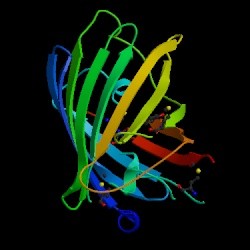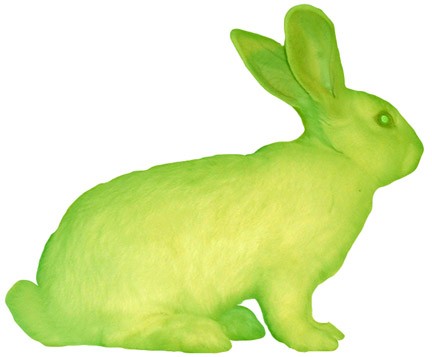
Protein Spotlight Issue 11; June 2001
MIRROR MIRROR ON THE WALL WHO IS THE GREENEST OF US ALL?
By Vivienne Baillie Gerritsen
Poem by Christopher Dinesh Raj
A bulb emitting light seems quite natural but a jellyfish? Well, bioluminescence existed long before the electric bulb. As early as the first century, Pliny described the light of Pulmo marinus, now known as Pelagia noctiluca, a purple jellyfish. Bioluminescence is a spectacular phenomenon and much research has been done since the 18th century. Jellyfish have been squeezed through cheese cloths, rubbed onto various surfaces or submitted to electrical stimuli, all for the sake of a green glow. Naturally, jellyfish are not the only species which luminesce. Corals, sea gooseberries, fish, bacteria, toadstools, plankton, fungus, glow-worms and many more also do. And the glow is not only green but for some, yellow, red, cyan or blue.
The Pacific Northwest jellyfish Aequoria victoria glows bright green thanks to a now highly popular protein: the green fluorescent protein or GFP. GFP is a spontaneously fluorescent protein. Shimomura et al. discovered it quite by chance in the 1960's. They had in fact extracted another luminescent protein, aequorin, which gives off a blue light in the presence of calcium. However, the jellyfish themselves give off a green light. Why? In a subsequent step, GFP transduces, by energy transfer, the blue chemiluminescence of aequorin into green fluorescent light. This is the glow that can be seen on the surface of seawater.
The structure of GFP was solved in 1996; it has a novel three-dimensional structure: the ß-can. The overall shape is that of a barrel, with a diameter of 30Å and a length of 40Å. Eleven tightly-fitted staves of ß-sheet form the body of the barrel (hence its name) and an a-helix runs up the axis. The latter forms a scaffolding onto which the chromophore of the protein is held. Besides the fact that the 3-D structure of this protein is quite beautiful, it forms a genuine protection against photochemical damage or the passage of unwanted diffusible ligands.

Figure 1 3D image of A.victoria's GFP
So, GFP's job is to make green light out of aequorin's blue light. How does it produce its own green glow in the first place? The chromophore is a modified Ser-Tyr-Gly sequence. GFP can actually glow once this short tripeptide has adopted a cyclic conformation with the help of a little oxygen. And it does this without any cofactors or enzymatic components.
This is what tickled so many biologists' fancy. Here is a molecule that can glow on its own. GFP has been expressed as a functional transgene and its use in cell, developmental and molecular biology is invaluable. Fluorescent GFP has been expressed in bacteria, yeast, slime mold, plants, drosophila, zebrafish and mammalian cells. It can be tagged to numerous other sequences without modifying its own function or their function. It has been used as a noninvasive marker in living cells, and can be used as a cell lineage tracer, a reporter of gene expression as well as a measure of protein-protein interactions. Naturally, a number of GFP mutants have been created: those that can tolerate more heat, those that give off a brighter glow or glow at a specific stage of cell development, those that are more photostable and so on.
Tobacco plants have already been engineered in order to track introduced genes. The recombinant tobacco plants glow green under ultraviolet light. It is important to know whether a gene which has been inserted into a crop, say for example, a gene which makes a plant resistant to a certain herbicide, stays within the crop and does not spread outside. A gene modified to make a plant resistant to herbicides, and which then spreads to weeds would be a bit pointless.
With the green glow came 'Transgenic Art'. Early on this year, an American artist, Eduardo Kac, displayed the first transgenic rabbit: Alba. When Alba is exposed to blue light, she glows green. Kac argues that the rabbit is his way of getting involved in the debate on the ethics of gene technology. Well, why not. I wonder what Alba thinks?

Figure 2 Alba, the fluorescent bunny
Why do animals and plants glow in the first place? No one really knows. Bioluminescence can take up to several percent of the cell's energy, so it should have an important role. Some believe it is used as a means of communication, either to attract prey or as a means of protection - a flash of light could scare off a predator. Another interesting hypothesis is DNA repair. In some bacteria, damaged DNA is repaired by an enzyme, photolyase, which needs light to function. In the ocean depths, there is no light. It may be that bacteria create their own light in order to repair their DNA.
Bioluminescence is also a military affair. In the First World War, soldiers used to smear their helmets with rotting wood - which is better than wearing a jellyfish - to avoid running into each other. At sea, when plankton is disturbed, it glows. Satellites, ships or aircraft are used to detect the telltale luminescent trails of submarines. This is how the German submarine U-34 was destroyed on November 9th, 1918.
The use of green fluorescent protein will no doubt grow, be it in the field of molecular biology, art and no doubt warfare. Even a poem has been dedicated to GFP:
The green gene
by Christopher Dinesh Raj
Oh, fluorescent one!
From the time they cloned you
And the time, I first set my eyes upon you,
Something drives us
To do something new with you.
You have been excited and emitted,
Mutated to yellow, cyan and blue,
Broken and permutated.
You have been driven with a promoter,
Be it viral T7 or the brain's own L7,
Been expressed in every cell type,
Fused to the you-name-it gene at the N or C terminal.
Confused, I am.
The cells don't mind you,
And the Ni-Nta columns will bind you,
Provided you have been His-tagged,
Only to make you pure.
You have been glorified here,
And stolen there,
Still you shine like an emerald in mother nature's crown.
Allow me to make a new construct out of you,
Mutate and transform you,
Shine some blue light upon you,
And I am certain my peers will turn green,
Yes, green with envy,
Because My GFP is brighter.
Cross-references to Swiss-Prot
P42212: Aequoria victoria green fluorescent protein
References
1. Tsien R. Y.
The Green Fluorescent Protein
Annu. Rev. Biochem. 67:509-544(1998).
PMID: 9759496
2. Yang F., Moss L.G., Phillips Jr, G.N.
The Molecular Structure of Green Fluorescent Protein
Nat. Biotechnol. 14:1246-1251(1996).
PMID: 9631087
3. Marchant J.
First Light
The New Scientist magazine, vol. 167, issue 2248, July 22nd 2000, page 34.
4. Schueller G.
But is it art?
The New Scientist magazine, vol. 169, issue 2272, January 6th 2001, page 34.
Eduardo Kac's web site: http://www.ekac.org
Protein Spotlight (ISSN 1424-4721) is published by the SWISS-PROT group at the Swiss Institute of Bioinformatics (SIB). Authorization to photocopy or reproduce this article for internal or personal use is granted by the SIB provided its content is not modified. Please enquire at spotlight@isb-sib.ch for commercial usage.
Back to Kac Web